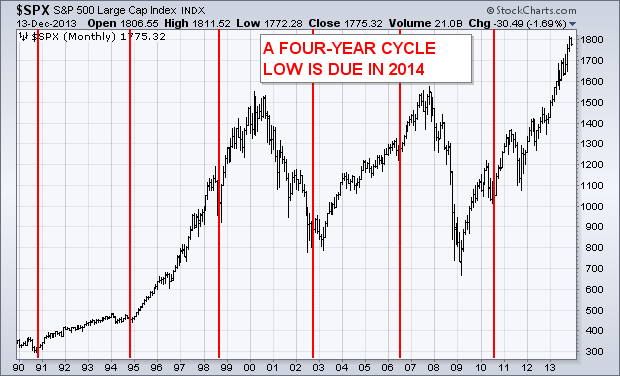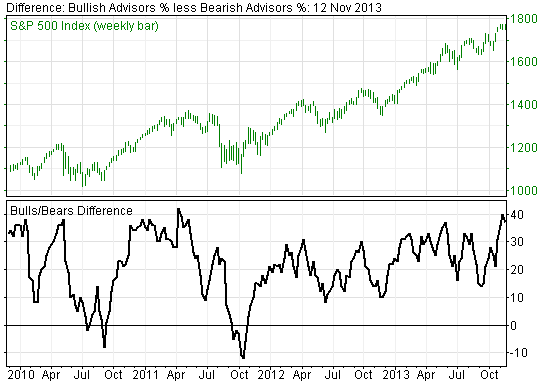According to the Stock Trader’s Almanac, the two first years of the Presidential four-year cycle are usually the worst with the last two usually the best. Bear markets usually occur during the first two years. Since 2013 (the first year of this term) was so strong, historical odds for 2014 (the second year) to suffer a correction are pretty high.  The chart above overlays four-year cycle lows on the SP 500 going back to 1990. The vertical bars show the last six bottoms occurring in 1990, 1994, 1998, 2002, 2006, and 2010. Earlier four-year patterns (not shown here) occurred in 1970, 1974, 1982, and 1987 (the cycle skipped 1978 while 1987 was a year late). Most of those bottoms took place during the second half of those years (mainly around October), and have coincided with midterm congressional elections. Assuming the four-year pattern repeats, the next bottom is due in 2014 and most likely during the fourth quarter. That carries both good and bad news. While the second year of a presidential term (like 2014) is usually the weakest, the third year (2015) is usually the strongest. If the 2014 presidential cycle holds true, the bad news is that it is likely to experience a noteworthy stock correction; the good news is that correction should lead to a major buying opportunity later in the year.
The chart above overlays four-year cycle lows on the SP 500 going back to 1990. The vertical bars show the last six bottoms occurring in 1990, 1994, 1998, 2002, 2006, and 2010. Earlier four-year patterns (not shown here) occurred in 1970, 1974, 1982, and 1987 (the cycle skipped 1978 while 1987 was a year late). Most of those bottoms took place during the second half of those years (mainly around October), and have coincided with midterm congressional elections. Assuming the four-year pattern repeats, the next bottom is due in 2014 and most likely during the fourth quarter. That carries both good and bad news. While the second year of a presidential term (like 2014) is usually the weakest, the third year (2015) is usually the strongest. If the 2014 presidential cycle holds true, the bad news is that it is likely to experience a noteworthy stock correction; the good news is that correction should lead to a major buying opportunity later in the year.
You might be wondering if every 2nd year of a presidency is bad shouldn’t I exit stocks now. My response is no, not yet. Since we cannot predict the future and seasonality patterns are NOT guaranteed, it is important to wait for a signal before you take action. One thing I like to do is watch how stocks perform in January. Why? Because a down January stock market serves as a warning – According to the Stock Trader’s Almanac, every down January for the S&P500 since 1950, without exception, preceded a new or extended bear market, flat market, or a 10% correction. 12 bear markets began, and ten continued into second years with poor January’s. When the first month of the year has been down, the rest of the year followed with an average loss of 13.9%. In most years, these declines later provided excellent buying opportunities. For example, 2008 was the worst January on record and preceded the worst bear market since the Great Depression. But 2009 proved to be one of the greatest buying opportunities in American history. For me until we get a signal otherwise, staying course with the primary bull trend makes sense but with a vigilant eye for some sort of a warning flag from the market is sensible.
Merry Christmas and Happy Holidays everyone. This will be my last post for 2013 so I wish everyone a warm, safe and prosperous 2014.





